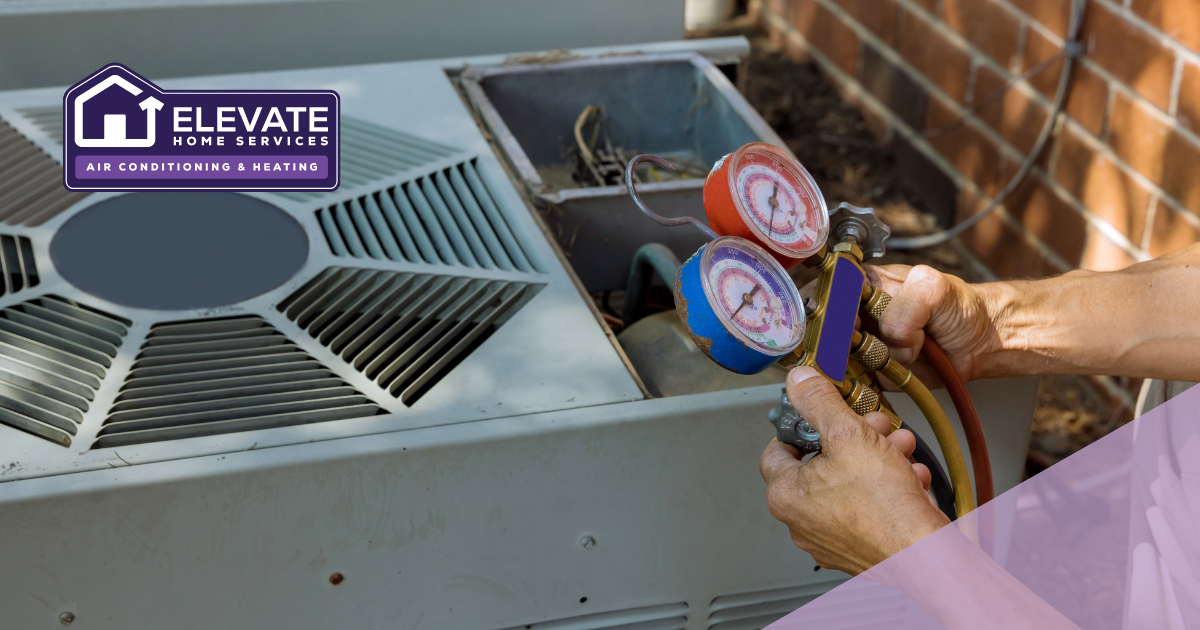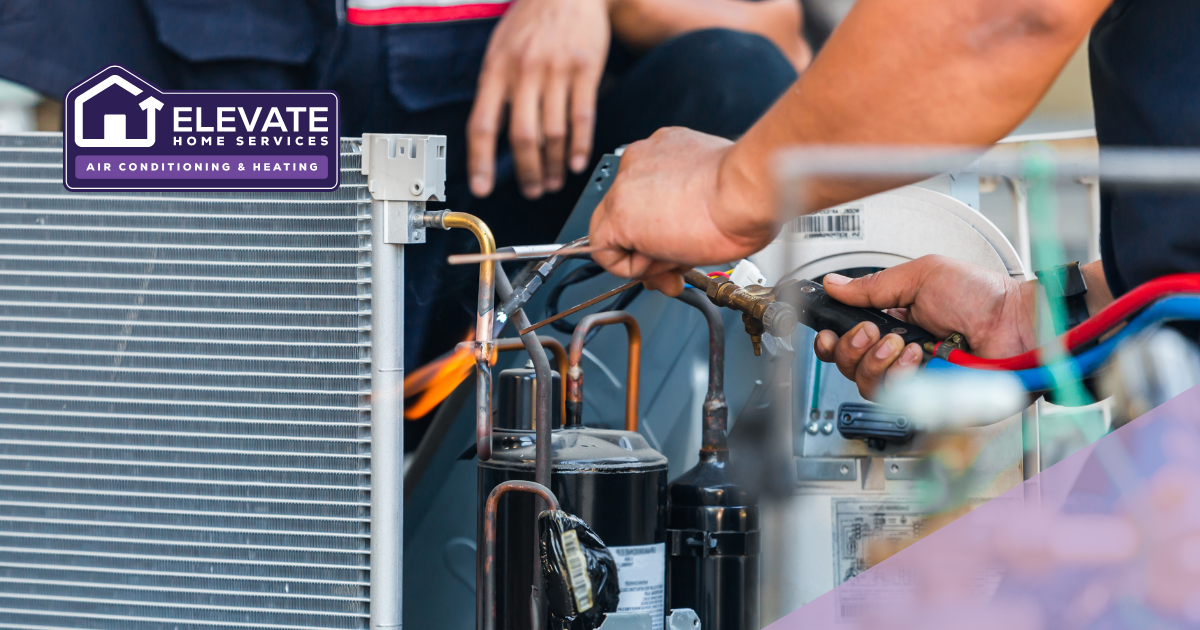You rely on your air conditioning system to keep your home at a comfortable temperature. But how exactly does it manage this? What does the process look like, and how do its parts work together to produce cooler temperatures?
At Elevate Home Services, we’re here to give you a peek behind the scenes. Discover more about the different parts of your system, the refrigeration process, and more.
Components of an Air Conditioning System
Your air conditioning system is complex. It contains many components, each of which must work together to help you keep your home comfortable.
The system itself can be broken into two parts: the indoor unit and the outdoor unit.
Indoor Unit
The indoor unit consists of several important parts, including the following:
- Evaporator coil: As the name implies, the evaporator coil evaporates liquid that runs through it. Essentially, liquid refrigerant runs through the coil and absorbs hot air drawn into the air conditioning unit, turning it into a vapor. The vapor cools and transfers back to the outdoor unit, a process that repeats over and over to ensure efficient cooling.
- Air handler: The air handler works to help move air through the air conditioning system (and your building in general) by transferring warm air to the outer unit and cool air to your home.
- Blower: The blower works in tandem with the air handler, helping to push conditioned air into your ductwork.
Outdoor Unit
Your indoor unit isn’t the only part of your air conditioning system. The system includes an outdoor unit, as well, to help circulate air and remove heat from the home. Refrigerant cycles between these two units, facilitate this process.
The outdoor unit includes the following:
- Condenser coil: The condenser coil is what helps to release the heat the refrigerant collected as a gas. When the refrigerant passes through the condenser coil, it condenses from a gas back into a liquid, letting it flow back to the evaporator coil.
- Compressor: The compressor coil helps to move the refrigerant through the condenser coil, helping to cool indoor air.
- Fan: The fan in the outdoor unit blows air over the refrigerant, helping to cool it down after it collects excess heat.
The Refrigeration Cycle
The refrigeration cycle is the most important function of your air conditioning system — it’s what allows you to keep your home at a comfortable temperature. Each part of the air conditioning system works in tandem to ensure this process proceeds smoothly.
The refrigeration cycle begins when refrigerant — that is, the liquid responsible for heat transfer — moves to the compressor. The compressor condenses the refrigerant (currently a low-pressure gas) into a high-pressure gas and then passes it along to the condenser coil.
The condenser coil releases the heat the refrigerant collects outside. Without the extra heat, the refrigerant returns to a liquid state and flows through the expansion valve and into the evaporator coil.
The evaporator coil turns the refrigerant back into a low-pressure gas. This gas absorbs heat from the indoor air, helping to make it cooler. From there, it’s sent back to the compressor, where the process repeats itself.
Understanding Air Distribution
The refrigeration cycle is incredibly important, but it wouldn’t do much if the air didn’t make it into your home. Air distribution is key to making sure you can enjoy a comfortable environment.
During air distribution, the indoor unit’s blower takes conditioned air and sends it toward your ductwork. This air passes through the filters, which remove contaminants like dust, allergens, and bacteria. From there, the air flows into the ductwork, which distributes the air to the rest of the property.
If you want to make sure your building’s comfortable, then proper duct design is key. You need to make sure that air can flow properly through the ducts and easily reach every room; otherwise, your central air system can’t do its job properly, which may mean that some rooms will be warmer than others.
The Importance of Thermostat Control
Your climate control system can’t keep things comfortable without a little help. It needs to know when to turn on and off; otherwise, you would have to turn it on and off manually, which could lead to uncomfortable interior temperatures.
The thermostat helps your cooling equipment do its job. The thermostat senses what the current temperature is and, if it’s higher than the set temperature, turns the air conditioner on. Once the temperature reaches what the thermostat is set to, it turns the system off again. This way, it can help you keep your home at the ideal temperature.
Modern technology has helped improve thermostats and make your life much more convenient. Most options include programmable or smart technology, which lets you easily schedule temperature settings, make adjustments remotely, or even integrate your system with other smart home features. Not only do these features make your life easier, but they can also help you save energy and, therefore, money.
Need Help With Your Cooling System? Reach Out to Elevate Home Services Today
Your air conditioning system is a complex machine that works diligently to help keep your home cool. By cycling refrigerant through several different parts, it can effectively cool indoor air and transfer heat outside the home. Combined with the ductwork and thermostat, your system can effectively make sure that your home stays comfortable — provided, of course, that each part continues working as it should.
No matter how well you take care of your air conditioning system, it may still experience problems. Parts can wear out or sustain damage, which may prevent the typical cycling process from occurring. When this happens, it’s time to call a professional for help.
At Elevate Home Services, we’re ready to examine your HVAC system and restore it to its former glory. Give us a call today at (239) 572-4075 to schedule a repair, inspection, or installation and leave your air conditioner system in the hands of professionals.



